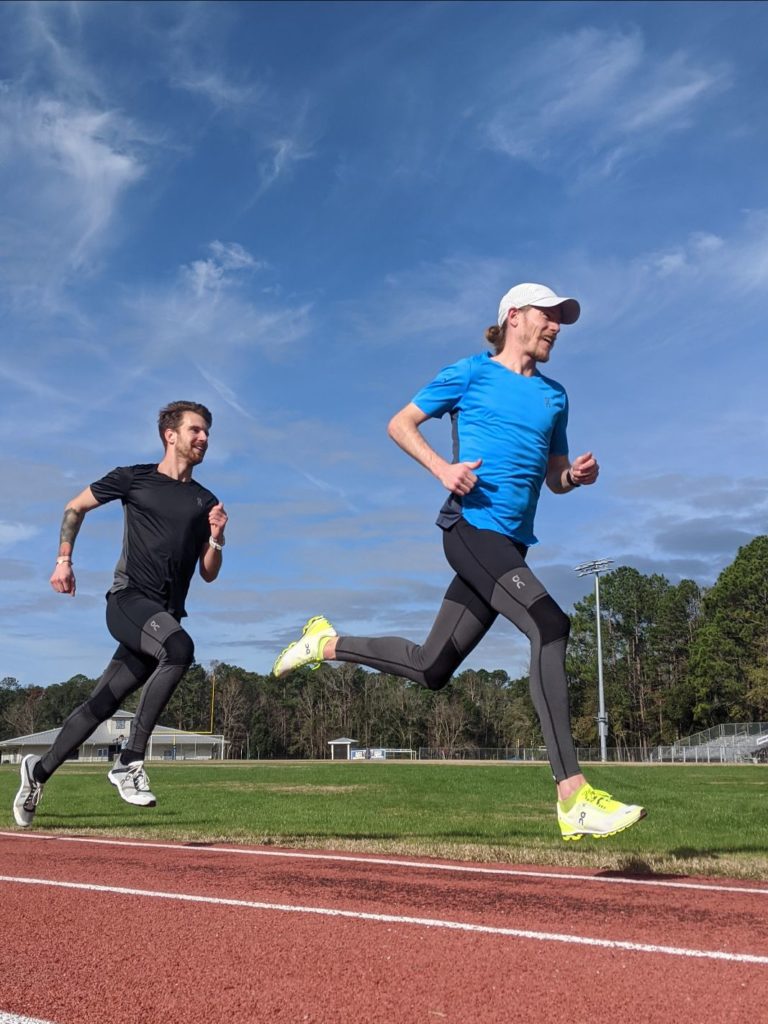Cold weather is here so let’s review best practices when it comes to staying healthy and getting the most out of your winter running. Whether winter means frozen eyebrows or deciding between short sleeves and long sleeves, here is a list of ZAP winter running rules:
Winter Running Rule #1: The 50 Degree Rule
The most important thing you can do this winter to reduce your injury risk is to keep your legs warm. I know this isn’t a popular opinion, but grab a spoonful of sugar and take your medicine: if it’s below 50 degrees (10 Celsius) you should be covering your legs during your easy runs with long tights or pants.

This is a no compromise rule for our ZAP Endurance team. Muscle and tendon strains are more common in the winter because cold temperatures make our muscles and tendons more rigid. When muscles and tendons are more rigid they are more susceptible to tears and strains. When muscles and tendons are shortened and our pace still demands the same range of motion, something has to give. As the weather grows colder that something is more and more likely to be your body.
This is why you’ll see sprinters warming up in pants when it’s 85 degrees out. They want their muscles and tendons to be as pliable as possible so they can move through their range of motion smoothly without strain. Easy distance running doesn’t require that level of pliability, but the point remains. Keep your legs warm to reduce injury risk.
Winter Running Rule #2: Warm-Up Before Your Run
Jump starting the warm-up process before you head out the door is helpful throughout the year, but particularly in the winter (see explanation of Rule #1). Incorporating some light activation exercises (such as clamshells, donkey toes, squats and lunges) will help activate your muscles to improve your mechanics. It will also improve blood flow so your muscles aren’t as stiff and rigid in the cold weather.
You can also jump on a foam roller before your run to wake up the legs and improve blood flow. Regardless, you should begin all your runs slowly to gradually increase the range of motion in your legs as your muscles and tendons warm up.
Winter Running Rule #3: Avoid Snow and Ice
For my friends that live in the northern tundra of the upper Midwest or Northeast you may scoff at the suggestion you could go the entire winter without running on snow or ice. That is my ideal suggestion. If there is snow or ice on the ground here in Blowing Rock the ZAP team is on the treadmill. Go ahead, call us soft, we can take it.

If you are going to run outside on snow and ice at least follow these rules: 1. Do not attempt to run fast workouts. 2. Make sure you have footwear with adequate traction.
Podiatrist Dr Robert Renaldi writes, “The most common winter running injuries are tendon and muscle tears caused by shivering, and metatarsal stress fractures, stress injury to the tibia, and Achilles tendon tendonitis, all a result of slipping on snow-packed roads.”
I retract my comment about pants being the most important thing you can do to stay healthy this winter. Pants and avoiding slipping and sliding on ice and snow are both the most important things. In addition to the issues Dr. Renaldi points out, I’ve seen a host of hip flexor & hamstring strains due to slipping. And I’m not talking about slipping and falling. That is obviously a very real and different injury risk. These injuries are due to that little slide on every stride experienced in slippery conditions.
Winter Running Rule #4: Adjust Workout Expectations
The winter is typically a great time for base building so ideally this suggestion isn’t terribly pertinent. However, if you are doing faster workouts during the winter it’s important to understand faster running at or below freezing temperatures will be harder. The faster you’re trying to move the more this will be true. Between the extra layers and the cold temperatures shrinking your airways and shortening your muscles, you’ll run a little slower.
And that’s ok. The right effort is what will allow you to improve, so focus on that and you’ll be golden.
Winter Running Rule 5: Increase Vitamin D
Vitamin D plays a number of roles in the body, but the most prominent role is to help with the absorption of calcium. Most people know that we get Vitamin D from the sun, but that is only part of the story. We do get Vitamin D from the sun, but it’s only available in one particular wavelength of sunlight, UVB rays. UVB rays require a sun angle of 50 degrees above the horizon or more in order to penetrate Earth’s atmosphere.
This means Vitamin D is only available via sunlight during certain times of the year. For most of North America that window is mid-spring to early fall. Moreover, even in the time of year where it is available, the amount we can produce in our bodies from sunlight is limited. And that limit is not enough to meet our needs.
You can get Vitamin D through a variety of foods, which is always the preference above supplements. However, for many people supplementing vitamin D can help prevent fatigue and bone related injuries due to not properly absorbing calcium.
Popular or not, I promise I’m only trying to be helpful. Here’s to a winter full of healthy running!